[ Life Cycle ]
Crashed and rebuilt, this Austin Allegro prototype became a rally car, then a museum exhibit. Brought back to life, it has been reunited with a previous driver to compete again
Words CHRIS WOOD Photography JORDAN BUTTERS
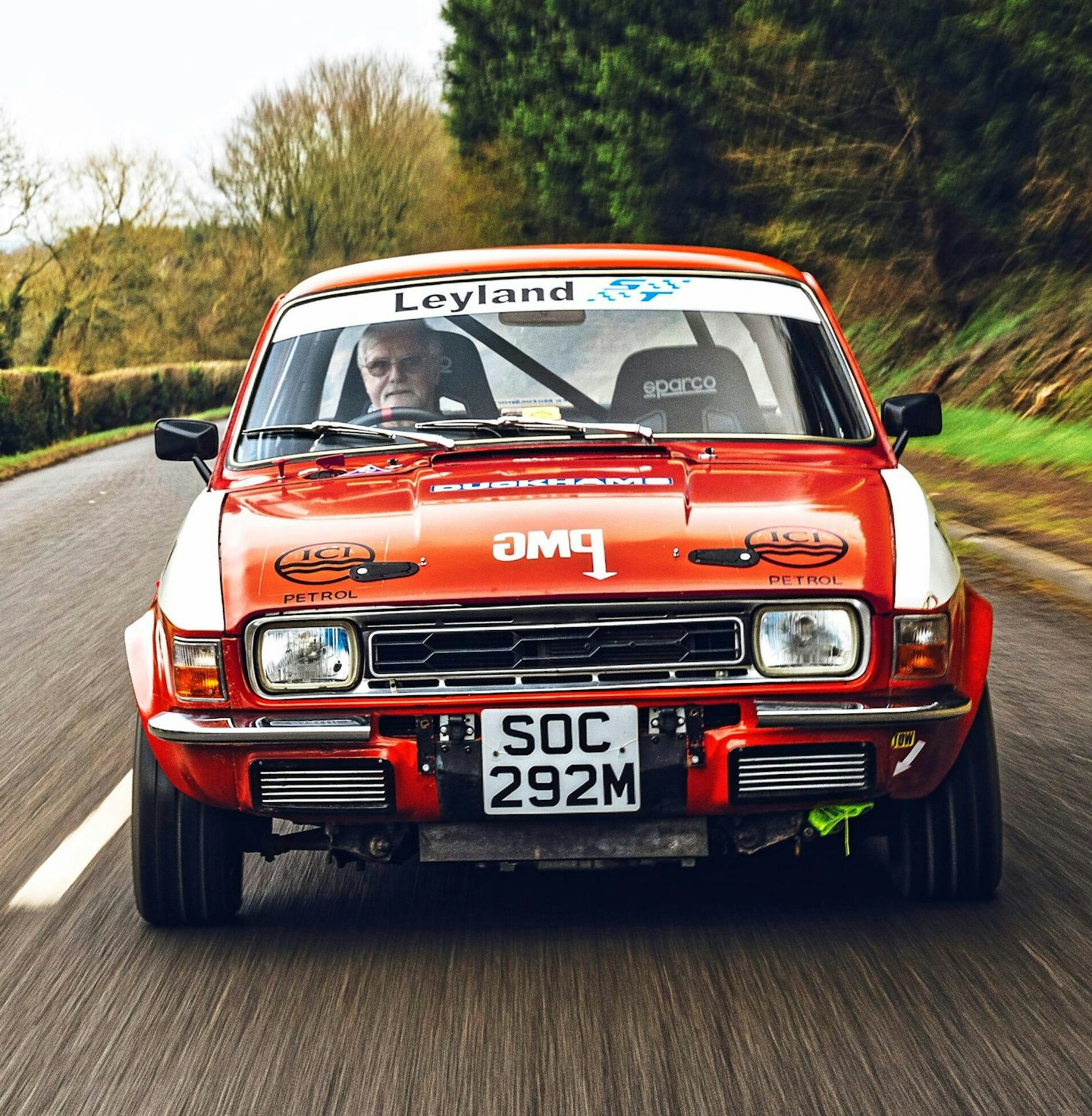
Reliability issues stopped Allegro socking it to its rally rivals in period
1972 – testing life of fifth Allegro prototype ends
Built in 1972 and in use as a general test car, the fate of the fifth Austin Allegro Fully Engineered Prototype (FEP) changed during its first year of life. With Don Kettleborough – a member of the experimental team at the British Leyland (BL) Longbridge car factory – on board, it was being driven in the Lickey Hills in Worcestershire. ‘I was sitting in the back seat and the driver indicated to turn right. I could see a Ford Zephyr coming the other way, but our driver obviously couldn’t – we met the Zephyr head-on, and it made a mess of the front of the Allegro.’
‘Following the crash, the car was rebuilt, and was used for suspension and handling work. As the testing process moved on, FEP5 was needed less and less, so it sat in a corner of the experimental department workshop. We managed to persuade BL management to let us use it for rallying. Up to that time I’d been rallying a Mini Cooper S, and fancied something with more power. It also appealed because it wasn’t going to cost me anything.
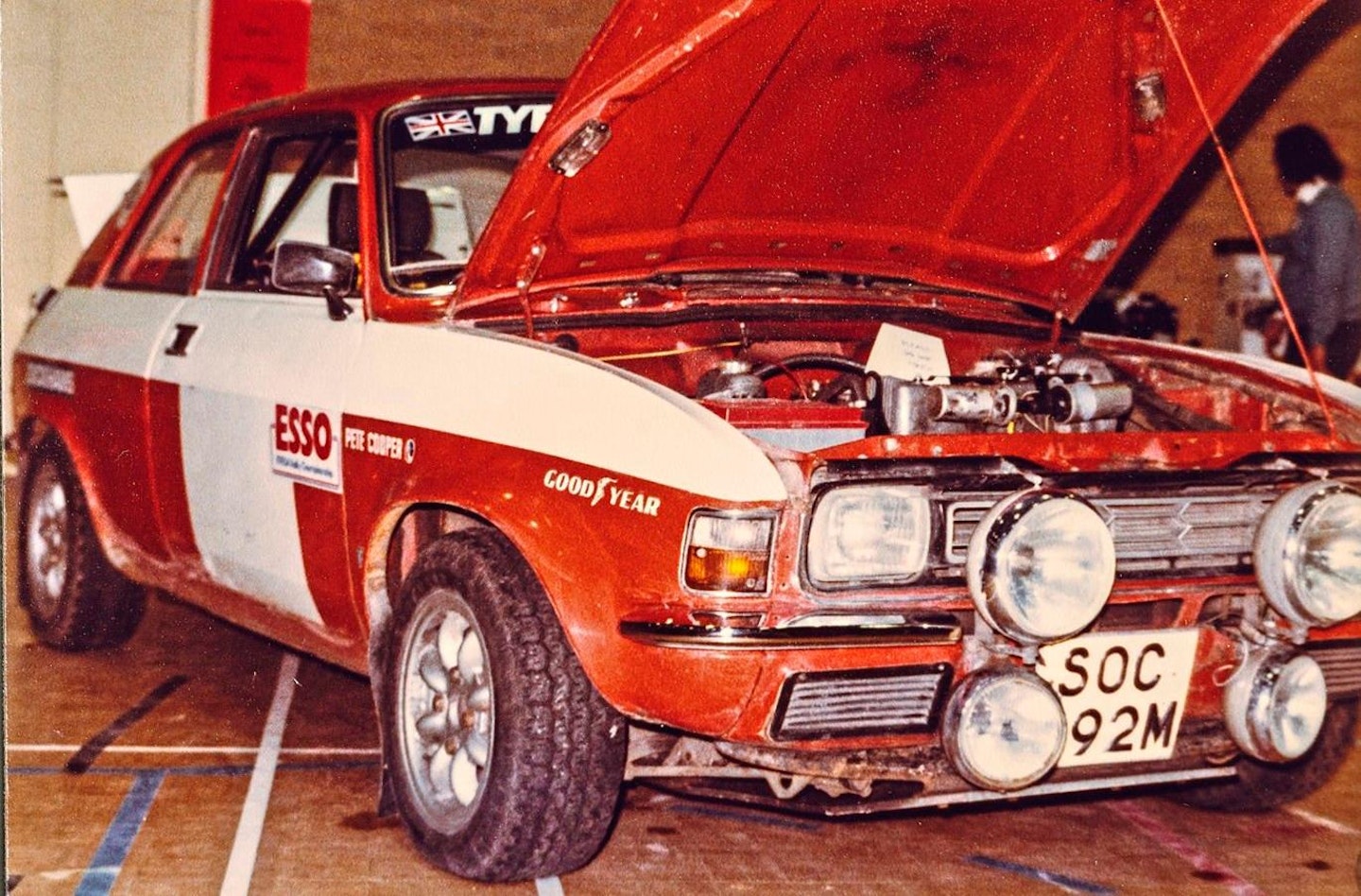
FEP5 only has a commission number, no VIN
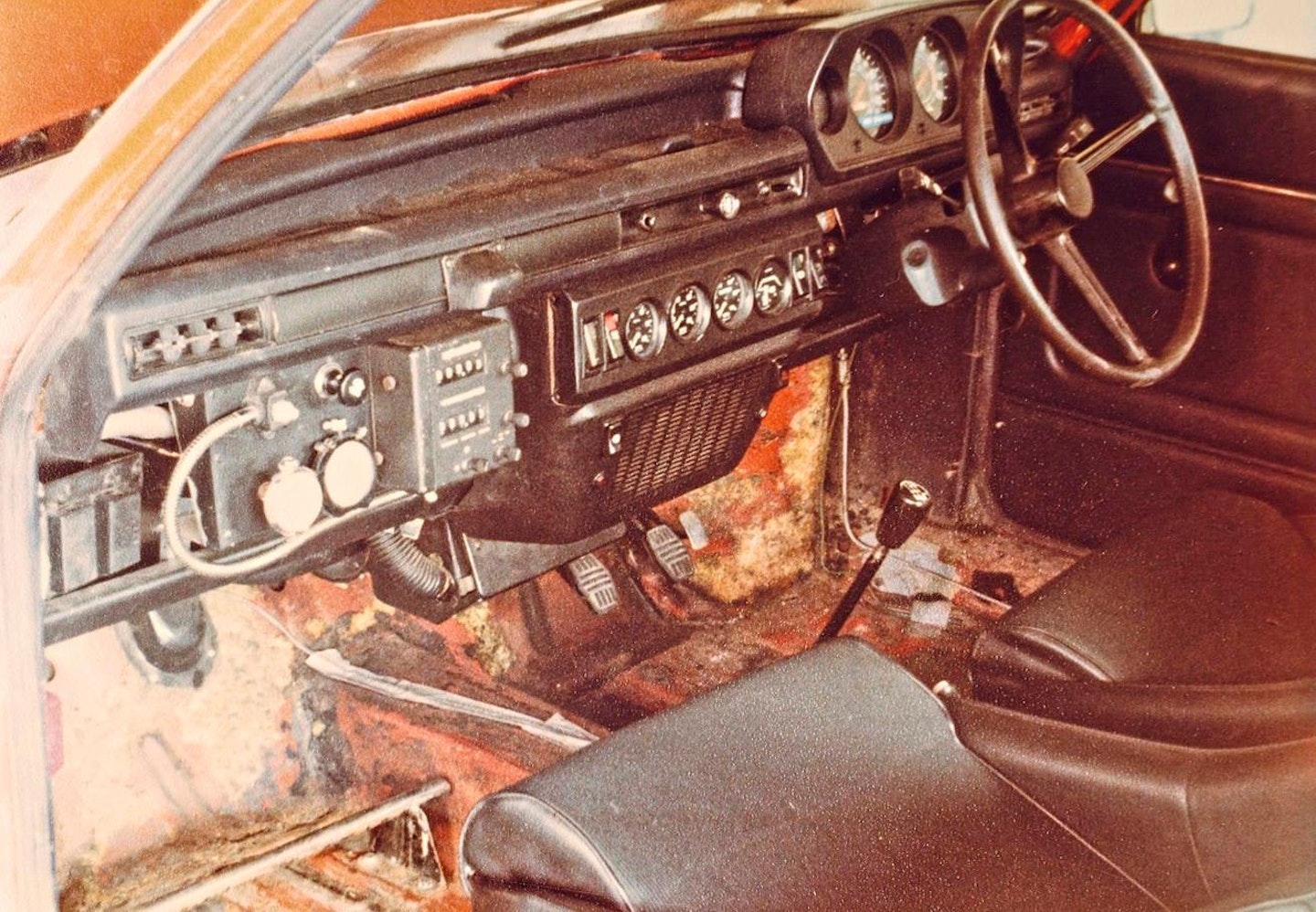
1973 Original main dials and dash not usual on a rally car
‘I had previously worked as a fitter, so could do any mechanical work myself. To locate the extra and uprated dampers, we fabricated some steel turrets, welded into the body. Longbridge was a busy place – contacts from the parts manufacturers came in every day; Girling provided the four-pot caliper brakes, also fitted to Volvo 240s. Working in the experimental team, and as an ex-Austin apprentice, I had contacts throughout the factory so could get anything made.’
The engine block was bored out, and using pistons from a Fiat 128, capacity increased from 1750cc to 1915cc. A pair of Weber twin-choke 45DCOEs replaced the standard SU carburettors, along with the exhaust manifold from the yet-to-be-launched Allegro HL. Power increased from 90bhp – the same as a regular 1750HL – to a useful 150bhp at 6000rpm.
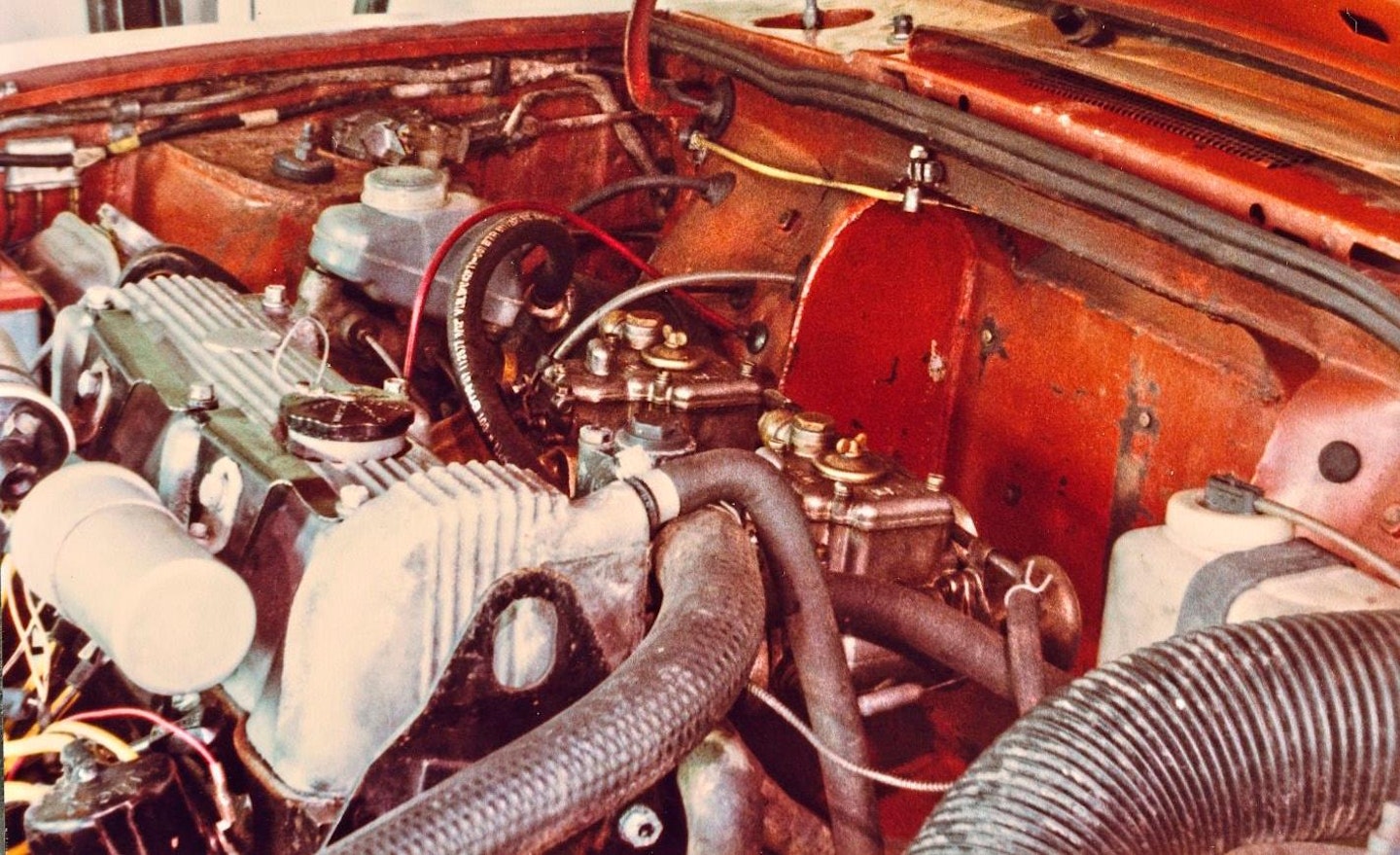
1973 Weber twin-choke 45DCOE carburettors feed rebored 1915cc engine
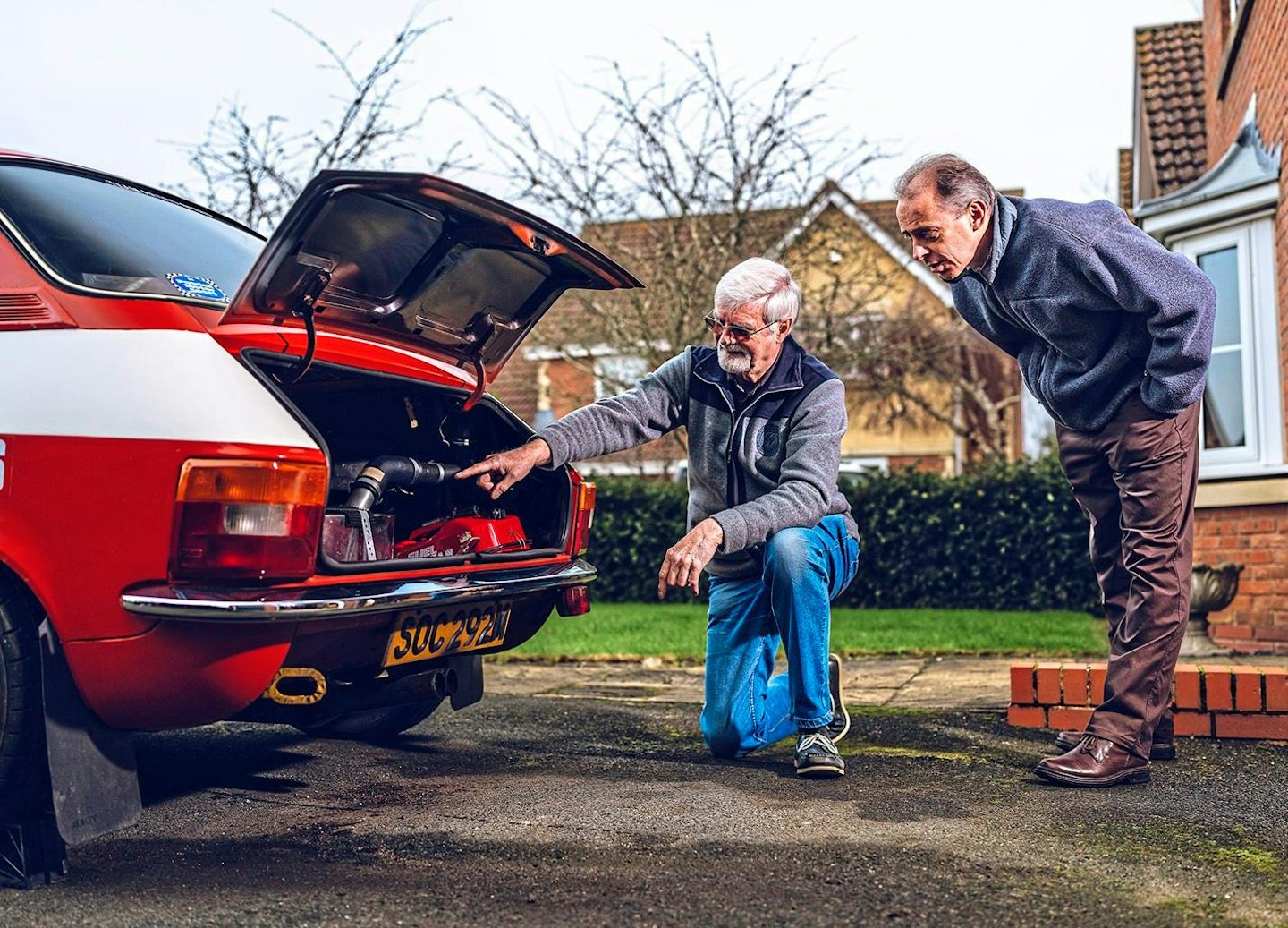
Peter shows writer Chris foam-filled 40 litre fuel cell that dominates boot
The first production car with Hydragas suspension, the Allegro used displacer units containing a rubber spring above each wheel. Partially filled with nitrogen gas and liquid, a flexible membrane separated the the two fluids. Similar to the Hydrolastic system used on the British Motor Corporation’s products in the Sixties, the units were linked on each side of the car to improve suspension control and ride. A more robust setup was required for rallying, so they were isolated at each corner. Dunlop produced special replacements without internal valves, because the standard units would have overheated due to the lack of fluid displacement.
Although it approved the car’s use for motorsport, the management at BL didn’t want FEP5 to be seen as a works vehicle, so Patrick Motors – part of the wider Midlands-based Patrick Motors Group (PMG) – became the entrant, its livery added to the Allegro’s body. The final change was an administrative one – BL wanted the Allegro to wear an up-to-date numberplate, so JUK 254K became SOC 292M.
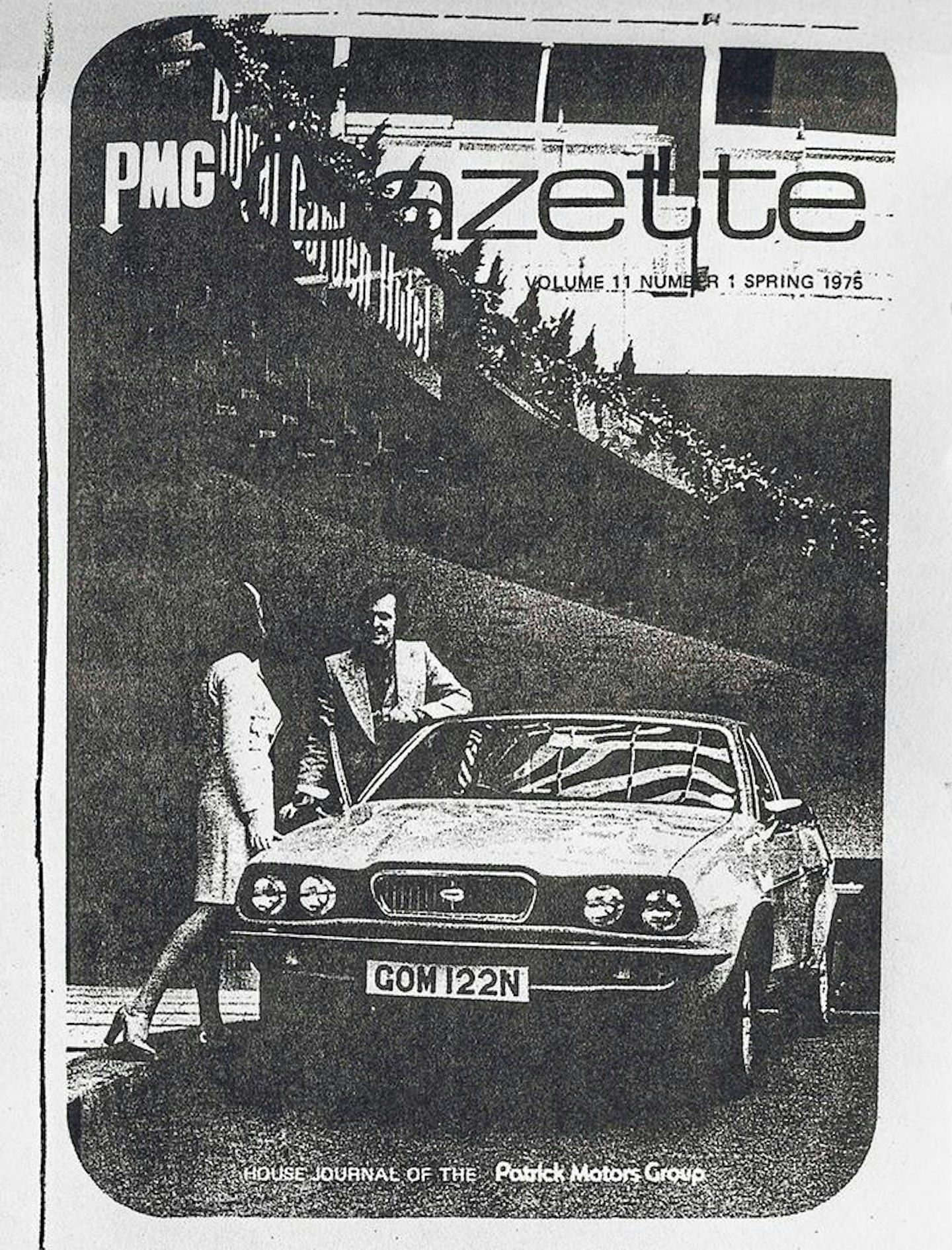
1975 The PMG Gazette – the Patrick Motor Group magazine
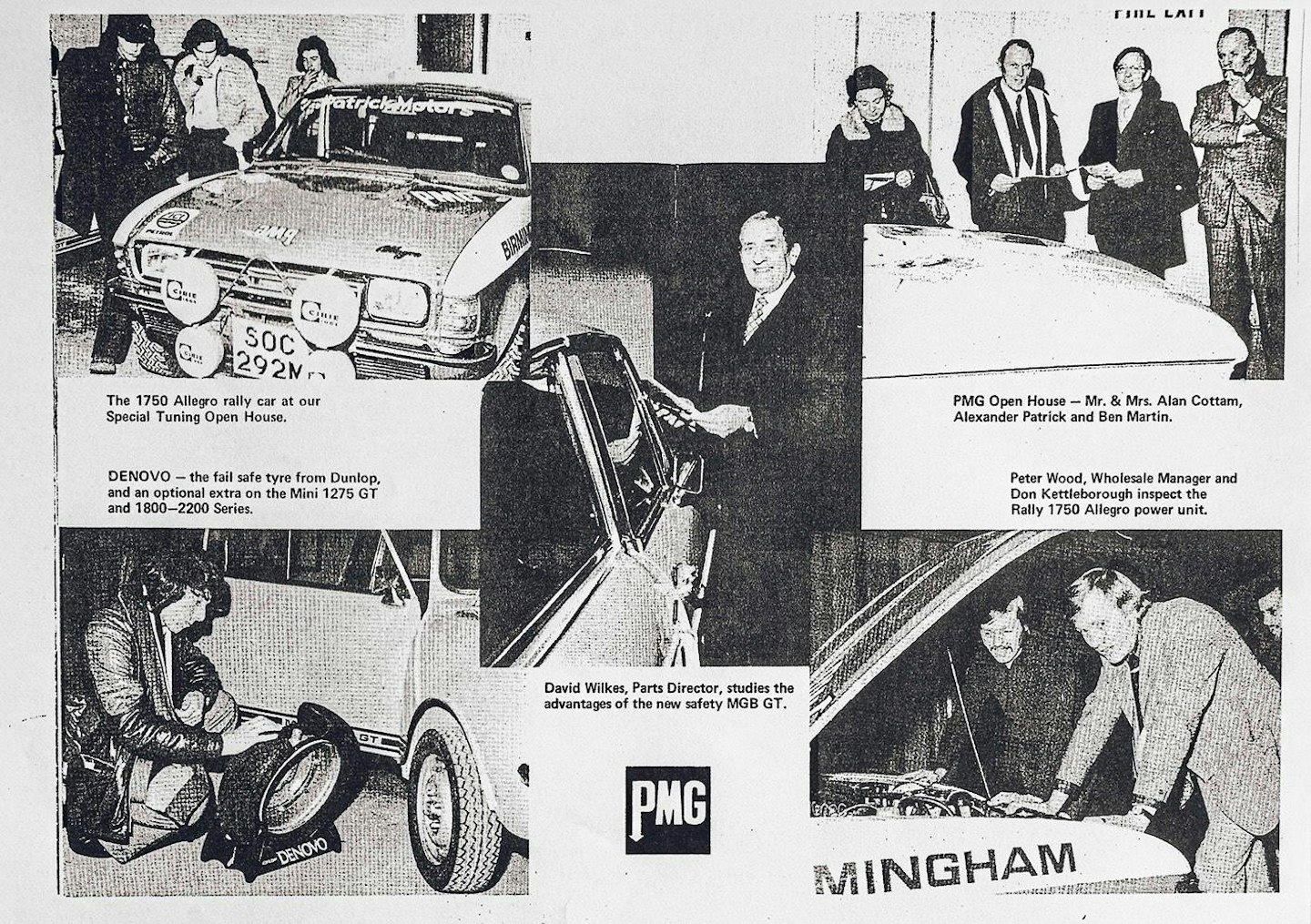
1975 BL didn’t want works entry; FEP5 competed under PMG name
Don began to compete in the National Road Rallies Championship and Motoring News events initially with navigator Denis Osborne, then with Mike Sones. ‘After an all-night drive in my rallying Mini, my hands would be red raw. The Allegro was much easier to drive and had lots of grip. We were competitive, but we were up against drivers like Tony Pond and Russell Brooks in Ford Escort Mexicos. They were top-class drivers and would have beaten me, even if they happened to be driving the Allegro!’
‘We had some good results – sixth in the Three Spires Road Rally in March 1975; seventh in the Border Uniflo Rally a month later; and we won the Wheelspin Road Rally the same month. We competed in 12 events during 1974 and 1975, but unfortunately, there were reliability problems – we’d be going well and then something would break. Each of the four times we retired we had a different issue, from a broken exhaust to an oil leak, as well as gearbox and suspension failures.’
Towards the end of 1975, BL’s interest in FEP5 reduced and the car headed for its next chapter.
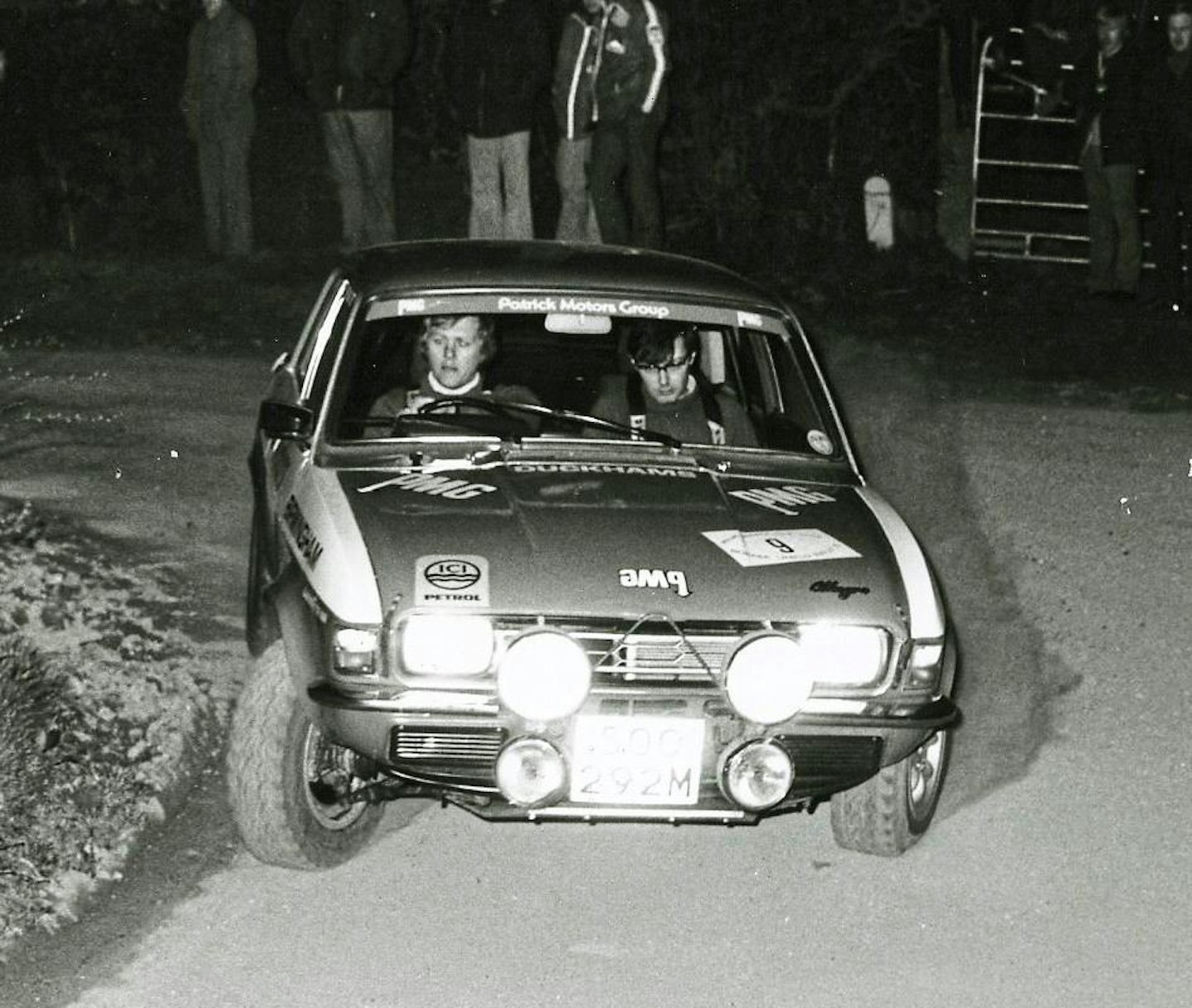
1975 Don Kettleborough and Mike Sones on the Border Uniflo Rally
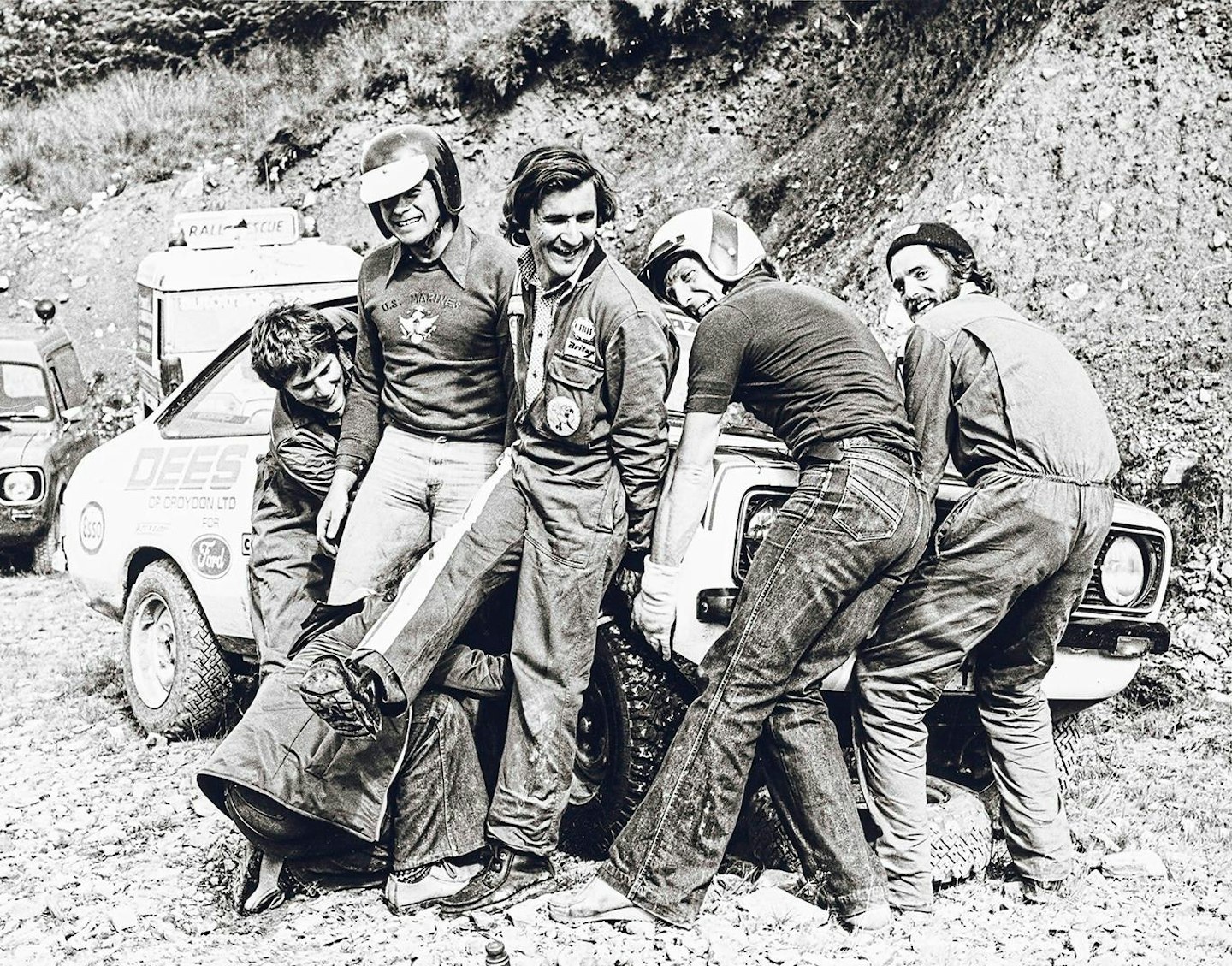
1977 Peter (far right) helps Derek Bell replace a tyre on his MkII Escort
1976 – FEP5 has several nights at the museum
The Allegro was then loaned to the Donington Collection, joining Tom Wheatcroft’s large museum of Grand Prix and racing cars for a year, after which BL Heritage requested the return of the car.
1977 – Peter Cooper finds FEP5 behind bike sheds
Peter Cooper worked as a development engineer for Land Rover. ‘Behind the bike sheds at Solihull was a building that housed cars from the BL Heritage collection, and I asked about the Allegro. “It’s a rally car, but we don’t know what to do with it,” was the reply. I got the go-ahead to give it a run around the test track. For an Allegro it was quick, and I persuaded the management to release it to me for rallying and other motorsport competition. I had been involved in rallying since I was 17, and as part of Rally Rescue, worked on event stage safety. I paid a peppercorn rent for the car – all the other costs were down to me and my navigator.
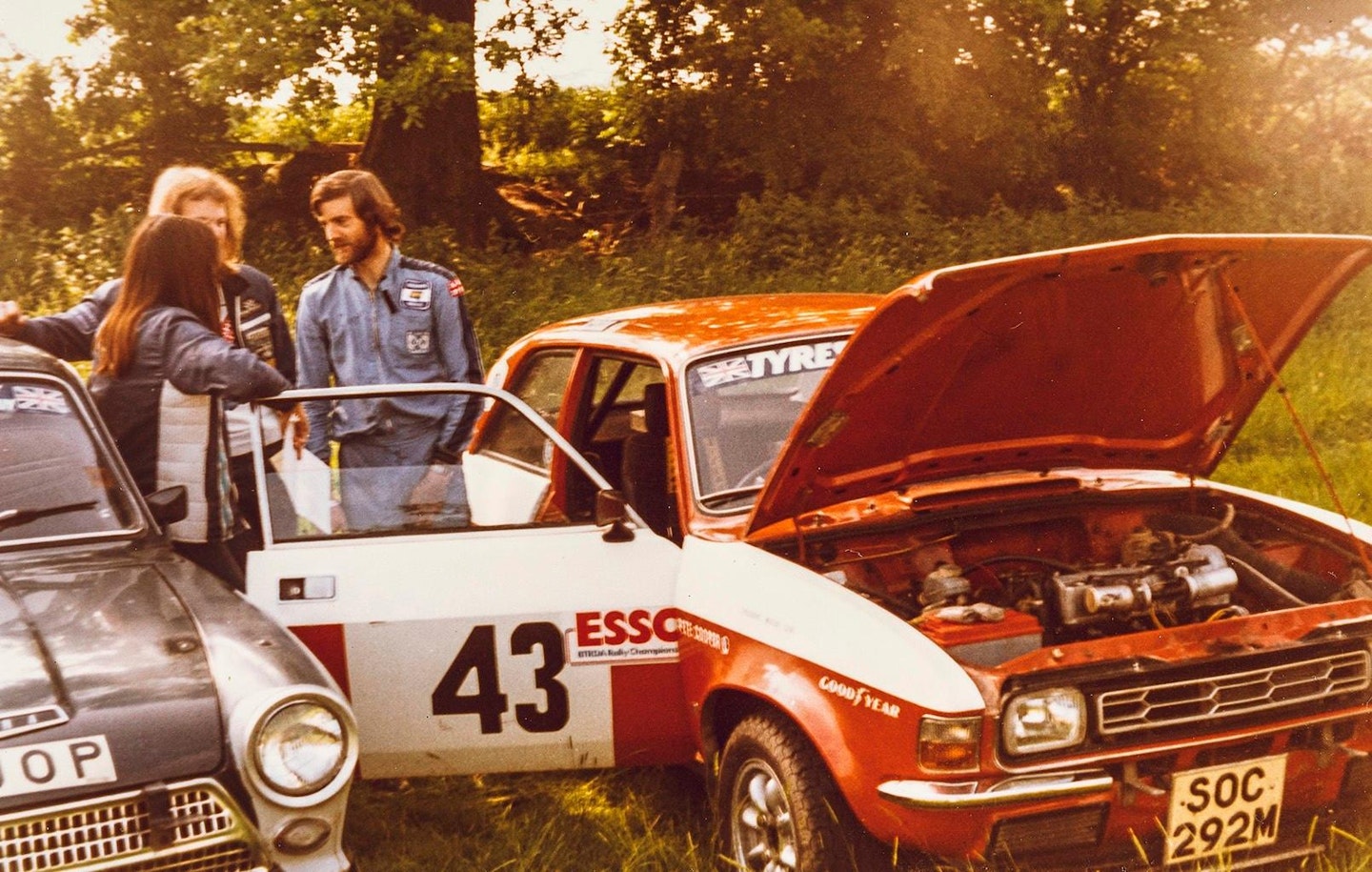
1978 Peter Cooper talking with Chrissie Ashford in the Curborough Paddock
‘Our first event was the Vagabond Rally in September 1977. We were fourth in our class on the Derby Crest Stages, and in November on the Little Rally Stages, we finished first in class and fourth overall, all very encouraging. Early in 1978, we had some problems with the gearbox, but we managed to fix it in time for the Graham Hill Trophy Sprint at Curborough. I shared the car with Chrissie Ashford, who went on to become British Ladies' Rally Champion that year. I was chuffed to be within 0.2 seconds of Chrissie, and this event would have some significance much later in the car’s life.’
In 1979 the car was back at Donington Park, but this time on the circuit. It had been resprayed in black and orange for the ‘Allegro’s got Vvvrrooomm’ advertising campaign and was on show at the BL Motor Sports Press Day. A cylinder head gasket failure, familiar to many Allegro owners, prematurely ended its involvement, though.
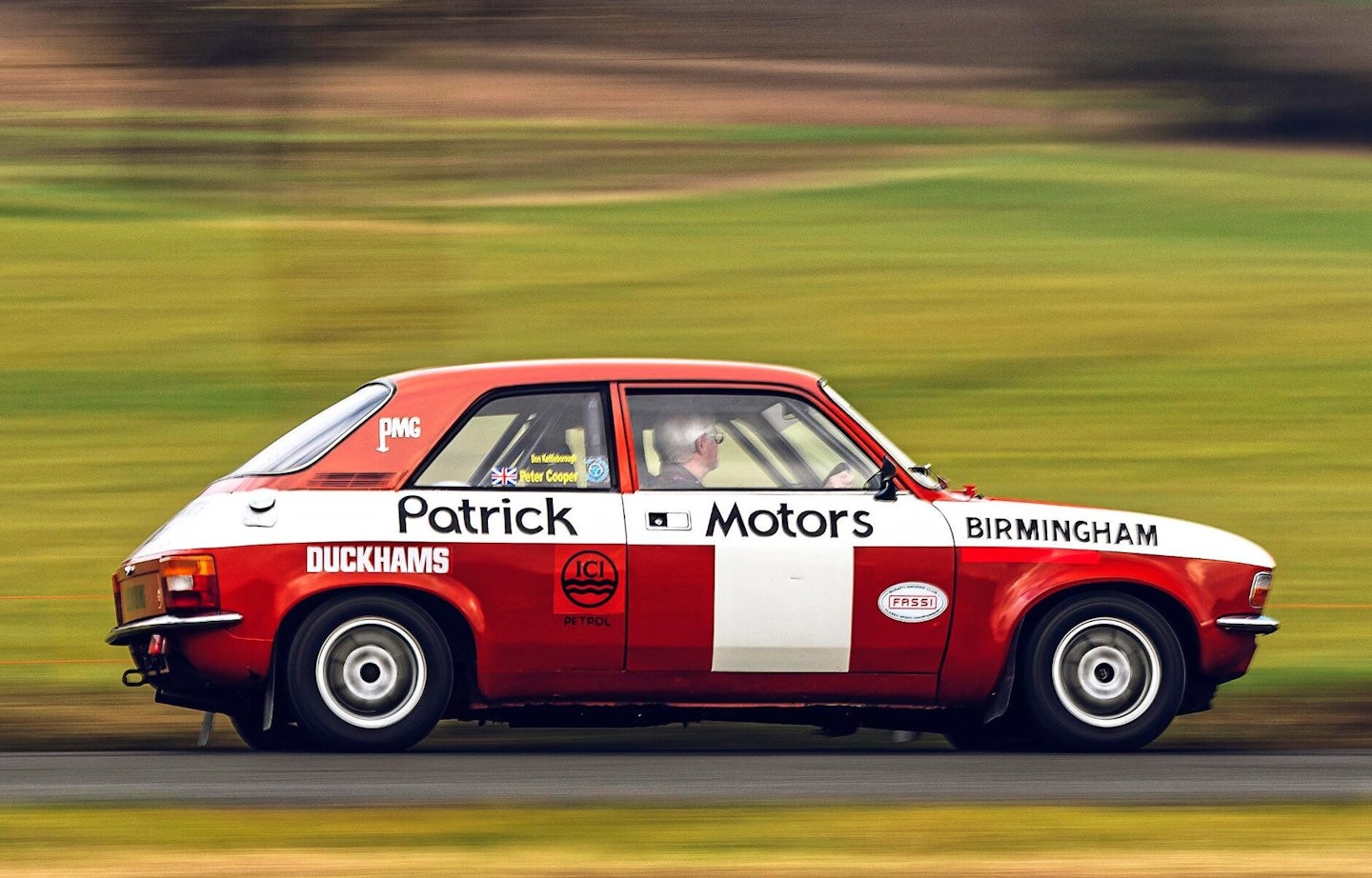
Harris Mann-designed Allegro was rarely seen as a rally car
‘For an Allegro it was quick, and I persuaded the management to release it to me for rallying’
The car’s run of bad luck that year continued. Driving around Birmingham to another event, it was rear-ended in a traffic queue by the crew’s own service van, which also pushed it into the car ahead. The resulting front and rear bodywork damage repaired, the whole car was resprayed black. After a small number of further rallies, the Allegro resumed a quieter life back with the BL Heritage Collection.
Early 1980s – The Patrick Collection buys FEP5
In return for having its name on the car, the Patrick Motors Group provided the fuel for competition use. The banners on each side of the Allegro reflected the two main locations – ‘Birmingham’ adorned the driver’s side; ‘Bournemouth’ on the passenger flank.
Managing director for Patrick Motors Group (PMG), Alexander Patrick, had been inspired by the mirrored writing on the front of ambulances. At his instruction, the PMG logo was added in a mirrored form to the front of the Allegro – he wanted anyone seeing the car in their rear-view mirror to be completely clear about the main sponsor.
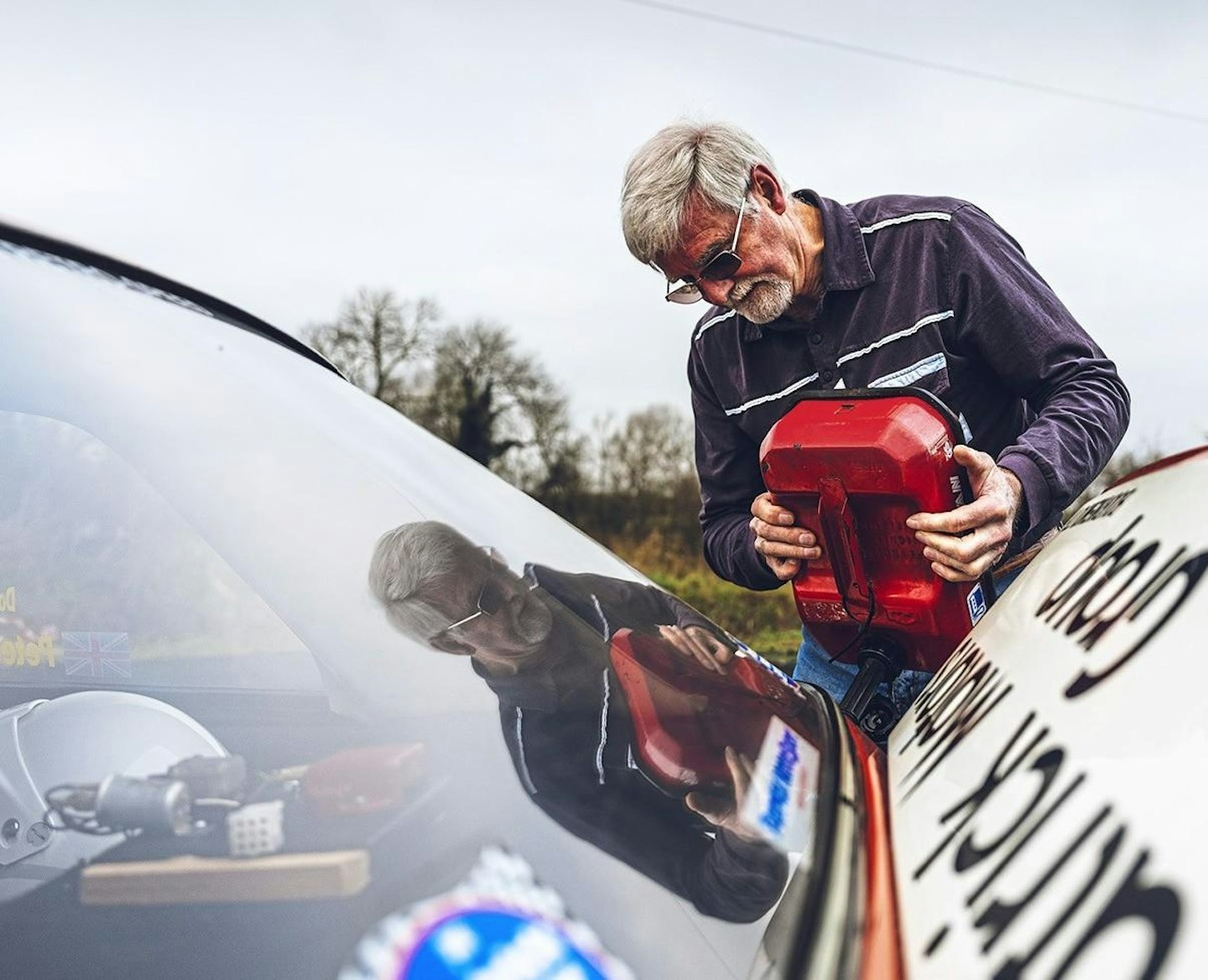
Peter tops up the super unleaded; the Webers are thirsty
The distinctive rallying Allegro was subsequently bought by The Patrick Collection, the museum operated by PMG. Resprayed back to the original colours of ‘Blaze’ with white stripes, the previous sponsorship livery was returned to the body and the car went on display at the purpose-built museum in Lifford Lane, Kings Norton, Birmingham. Peter Cooper visited the collection. ‘I asked the museum to contact me if the Allegro was ever put up for sale, because I would be very keen to buy it.’
Unknown to Peter, in late 1994, The Patrick Collection decided to auction part of its museum collection because of the prohibitive upkeep costs of many of the cars. Paul Vincent and Paul Foster were active members of the Allegro Club International and were tipped off by the club’s archivist, Colin Corke. ‘Paul Foster and I found ourselves at Olympia in London looking at Lot 93 of the Brooks auction and we were highly impressed by the extent of the modifications,’ Paul Vincent explains. ‘The catalogue estimated a sale price of £2000-£5000 and we set ourselves a limit of £2500 – the maximum our finances would allow. Sadly, we were outbid.’
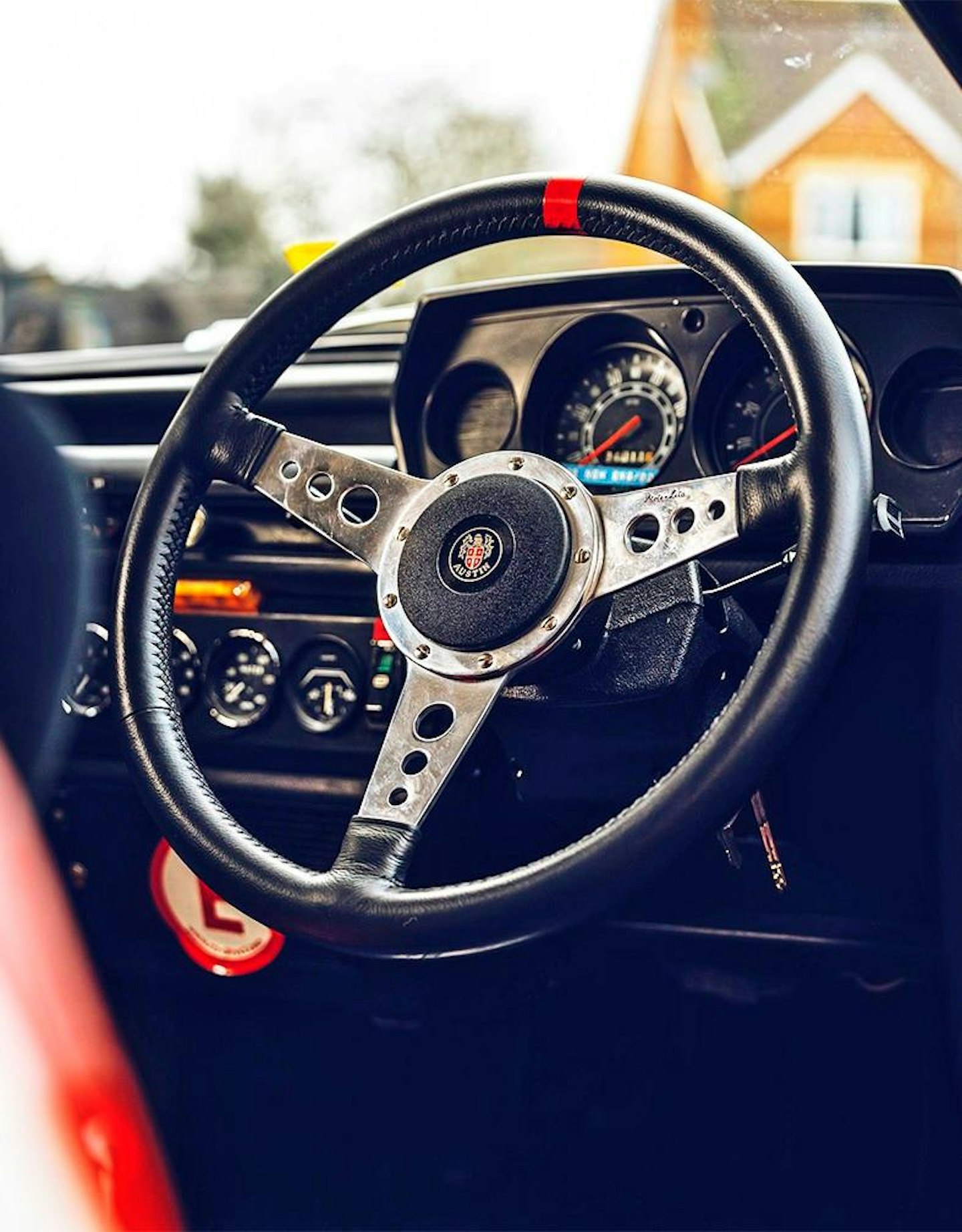
Moto-Lita wheel replaces famous quartic
1995 – the Pauls buy the Allegro for £3000
Paul Vincent continues the story. ‘In spring 1995, we became aware that the car was being offered for sale again, following a change of plans by the auction buyer. Paul Foster contacted the seller and atfter much negotiation, agreed a price of £3000. The car was delivered to me in Chippenham, Wiltshire, and stored in my garage. At the time, DVLA rules allowed a vehicle to be registered in joint names, so Paul and I both had our names on the V5 document. I arranged an MoT, we found a suitable insurance policy and FEP5 became fully roadworthy again.’
‘Our very first outing returned the car back to its natural environment. I had been a member of the Tavern Motor Club in Bristol for several years, regularly taking on marshalling duties. At the end of September 1995, we took SOC down to Wellington in Somerset to marshal on a couple of night sections during the historic Rallye Bristowe.
‘In 1996 we drove the car to the AGM of the Allegro Club International at Coventry Transport Museum and back to Chippenham. Later that year, we got to within half a mile of the Wroughton Festival of Transport when the engine stopped abruptly. Investigation soon revealed the rotor arm in the distributor wasn’t turning. I had encountered this on Maxis in the past and knew straight away the oil pump had seized. A Vanden Plas 1500 towed us to the show, and we arranged to be recovered home by the AA. The Allegro was then stored in the garage of Paul Foster’s grandmother in Luton.

1979 FEP5 a star in official BL press photo
‘Paul’s family were convinced the engine needed a full stripdown and refurbishment. Once removed, it was taken to a local specialist. As part of the rebuild, another set of 84mm Fiat pistons had been sourced and we had been advised that a custom-made copper/asbestos cylinder head gasket should be used – £3000 later, FEP5 was running again. A while later, the special head gasket failed and, after consulting former driver Peter Cooper, we opted for a good-quality standard gasket as usually fitted on regular BMC E-series engines.
‘A couple of years passed and Paul Foster’s father, Vernon, asked if I would be interested in selling my half-share of the car to him and I agreed, with the handover taking place in October 1999. At that particular point, I was ready to move on and explore other interests, although I was only able to get back my original £1500 investment.’
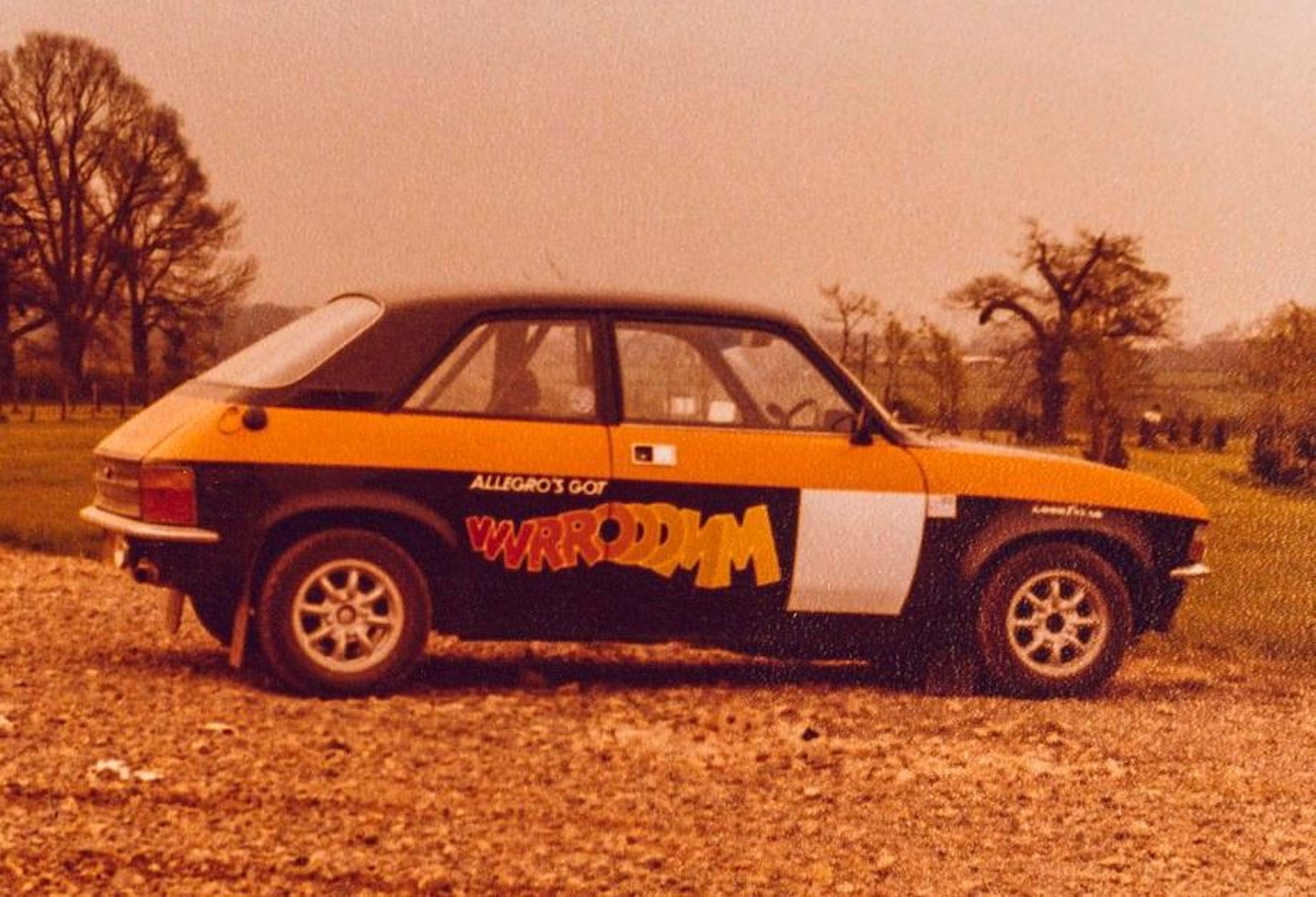
1979 Even added VROOM didn’t help Allegro defeat Escort Mexicos
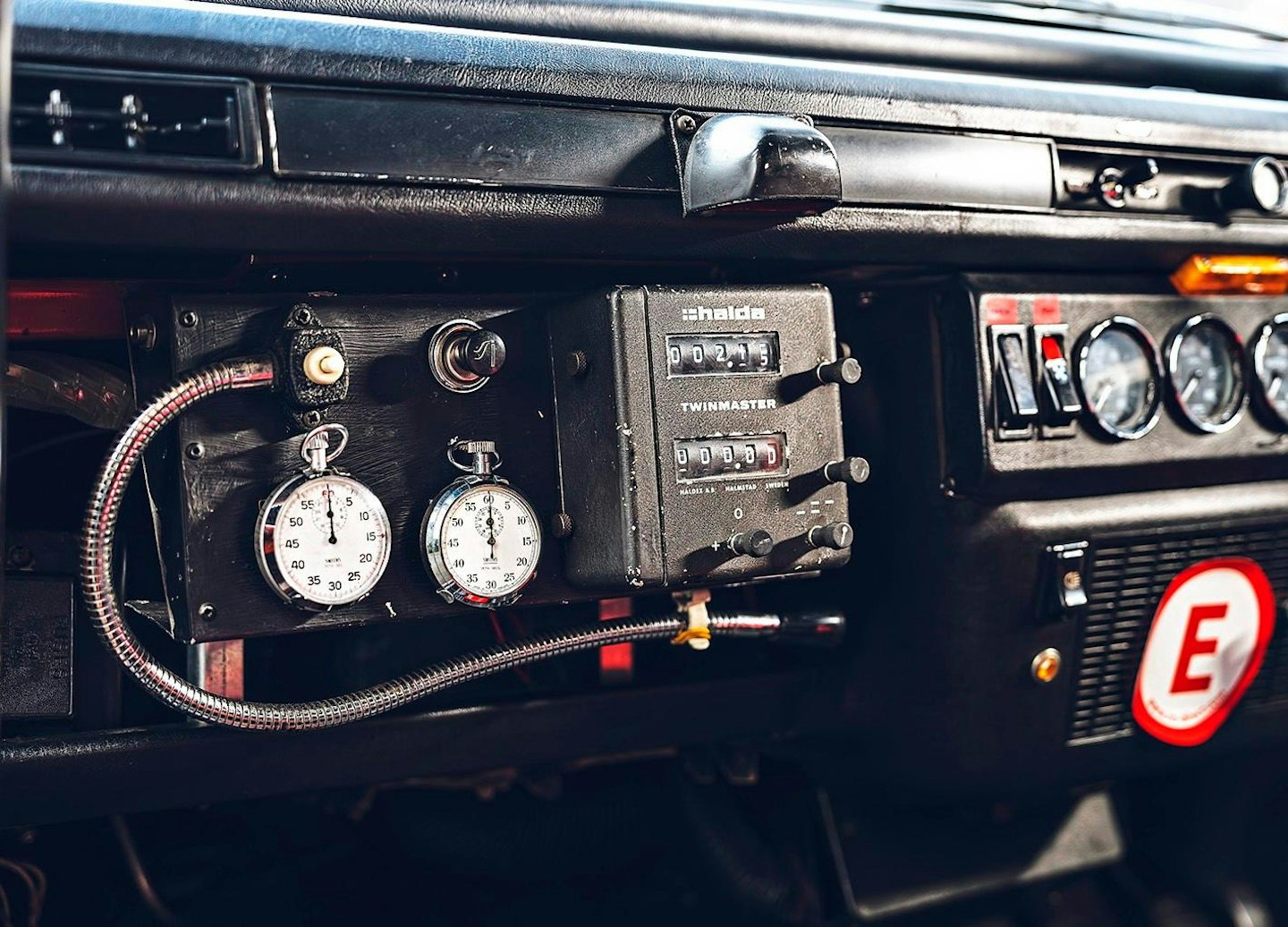
It’s not time up for this Allegro’s life as a rally car
‘Once Paul and I owned the car, further works were carried out to remedy the seriously corroded front chassis members,’ recalls Vernon Foster. ‘They were filled with post-rally gravel, following Peter’s many exploits with the car. Other minor mechanical jobs such as new tyres and brake shoes were also completed.
‘We continued with repairs and maintenance during our ownership, and FEP5 was displayed in a running condition at local car shows in and around Luton and even Allegro specific events. Peter Cooper was quite often at these events, too, and regularly reminded us that he would be a willing owner of the Allegro if we ever decided to sell it.’
2023 – Peter Cooper finally owns FEP5
After many years Peter’s persistence paid off, and he took ownership of the Allegro in February 2023, paying Paul and Vernon Forster a five-figure sum. Peter wished to see the car back in competition. ‘I wanted to see the car doing what it was built for and making best use of its unique engine. I set about recommissioning the car to compete in hillclimbs and sprints from April 2023 onwards.’
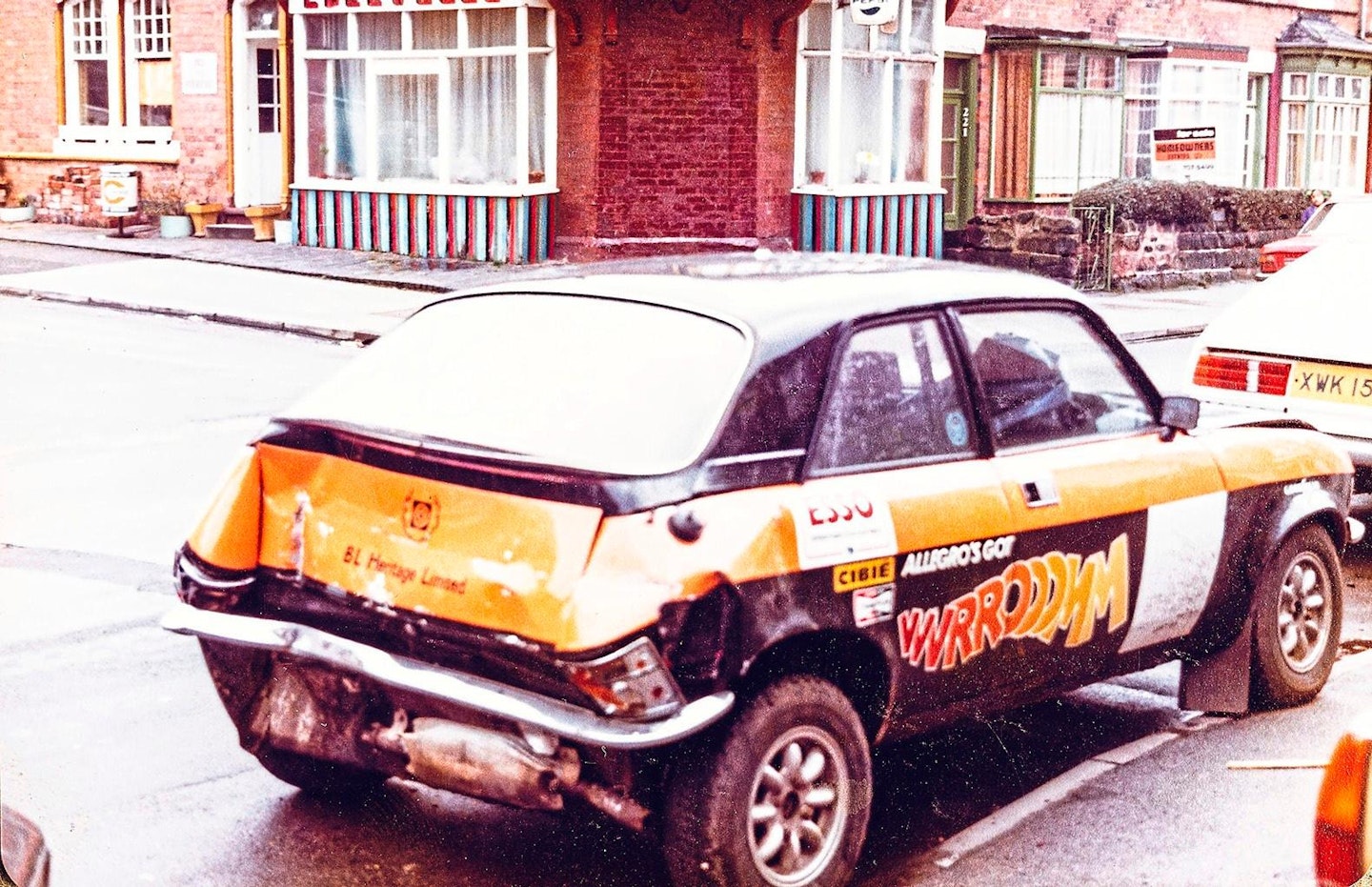
1979 Service crew van makes aerodynamic modifications
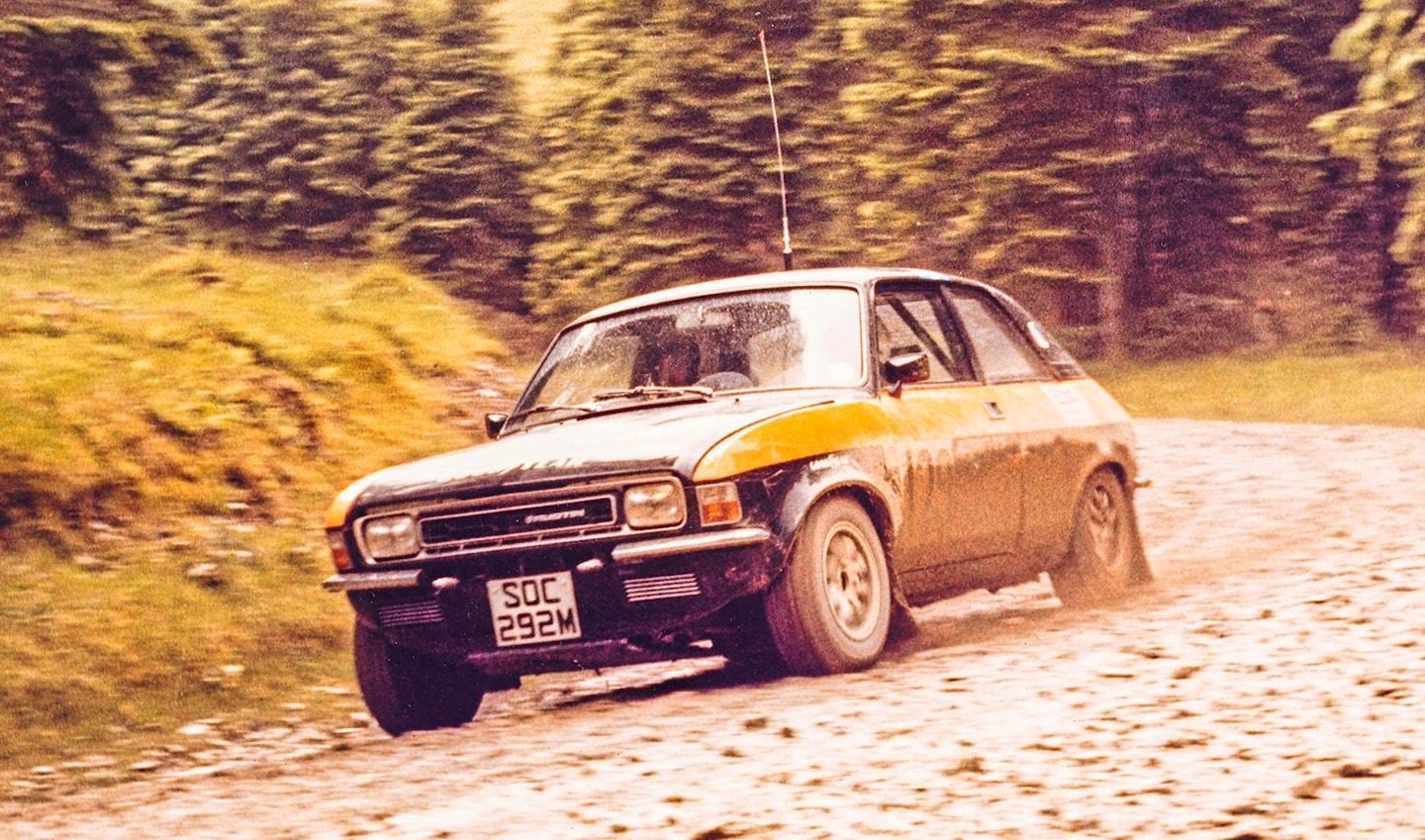
1979 Peter behind the wheel at the Rali Bro Myrddin in Wales
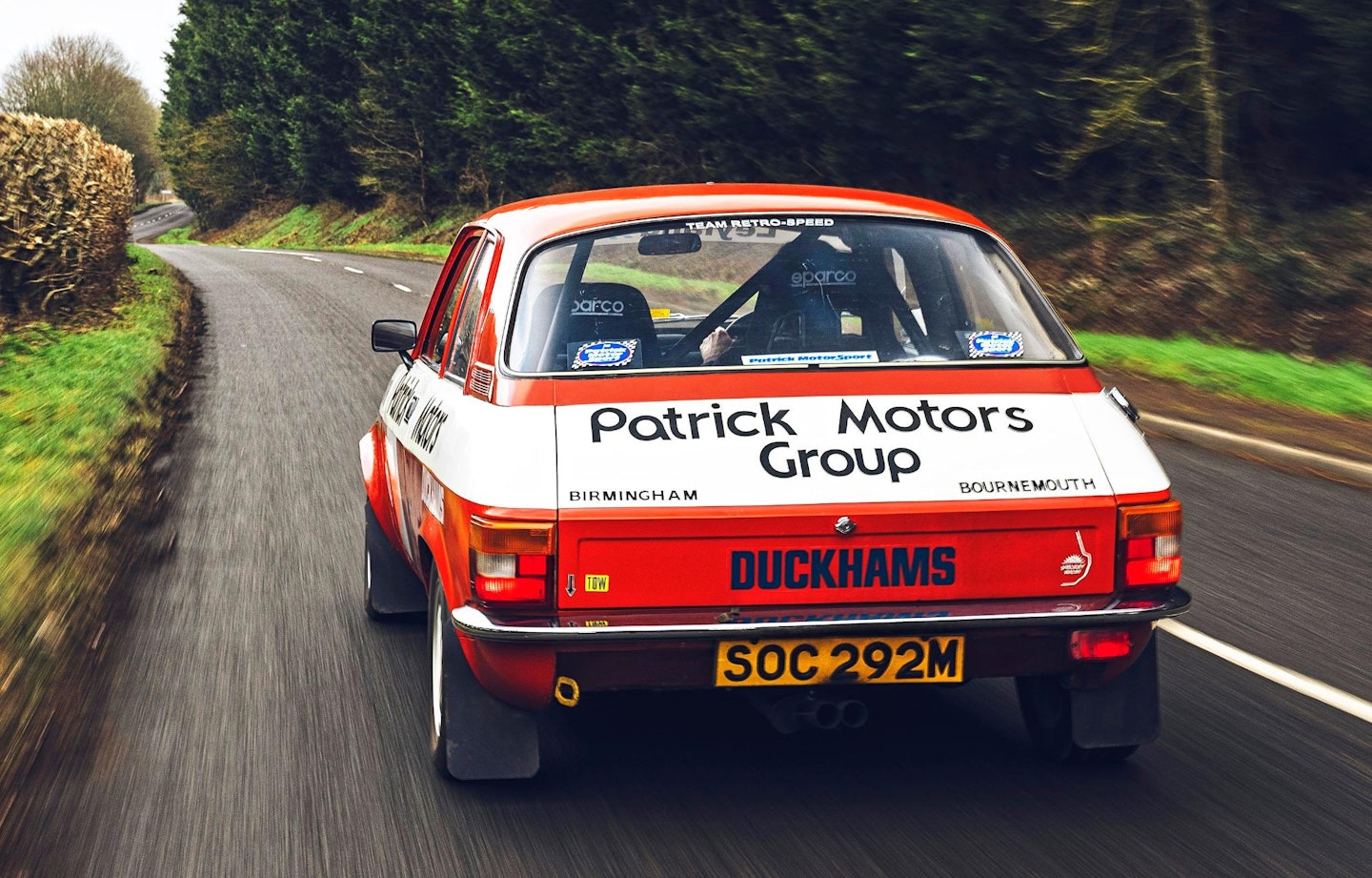
Back in original ‘Blaze’ and white colour scheme from 1974
‘I wanted to see the car doing what it was built for and making best use of its unique engine’
‘As the Allegro had only been lightly used, there were few issues that needed to be resolved. These included starting problems – the starter motor needed an overhaul and I fitted 12V coils; there was a lack of brakes, which turned out to be the need for a new master cylinder and brake lines; one of the petrol pumps needed reassembly; a new set of Yokohama tyres were fitted to the road wheels; and all four of the Hydragas suspension spheres needed replacing with new isolated units.
‘The car also had to be made up to date with current motorsport regulations in order to allow it to compete. While I was keen to keep it as original as possible, I had to accept that there were certain components that needed changing. Additions included a brand-new fire extinguisher system – linked to two nozzles within the cabin and two in the engine compartment – along with more modern four-point harnesses and racing seats. I also added the Super Oscar driving lamps, with their specially manufactured bespoke lamp brackets.’
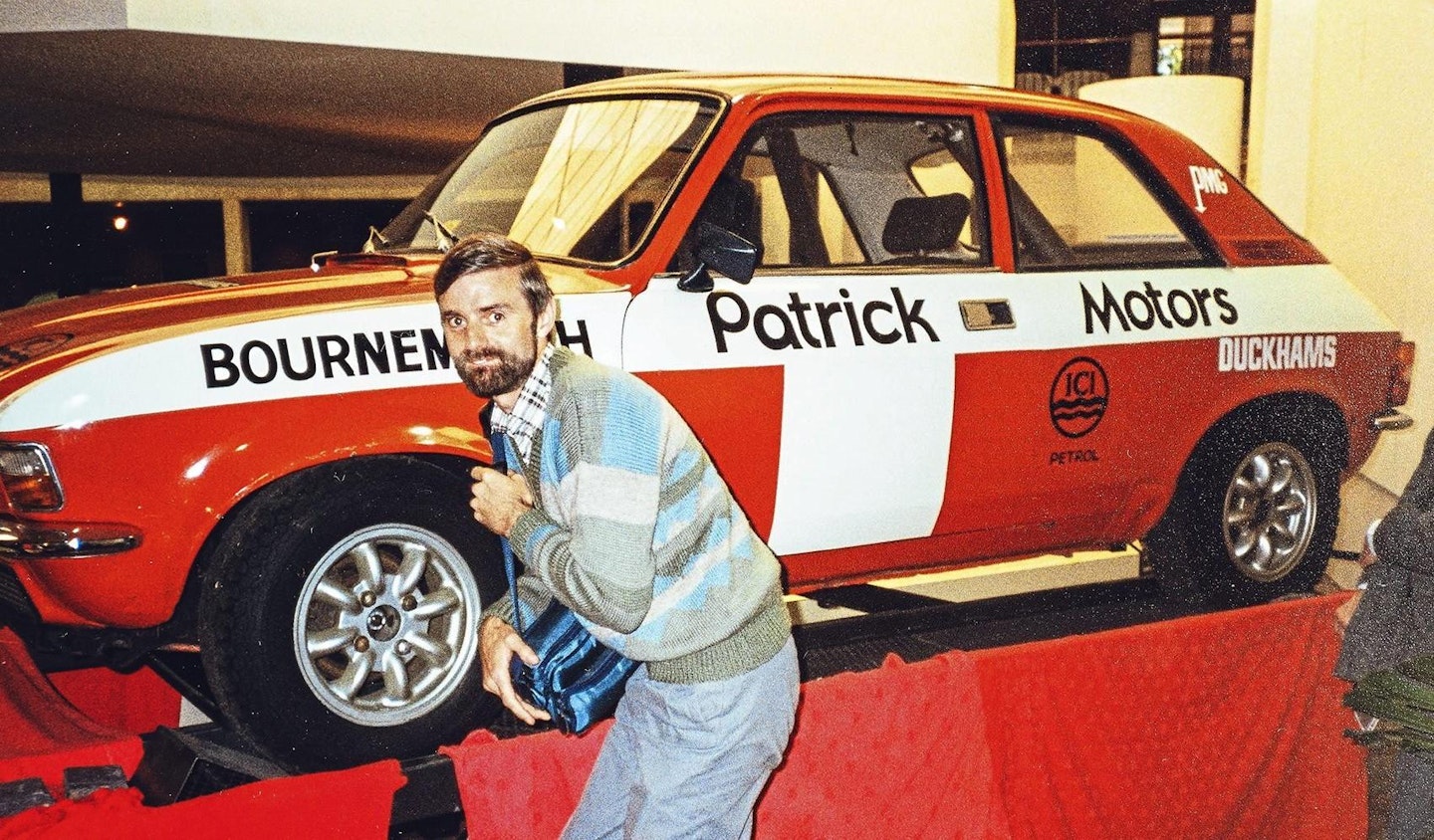
1980s Peter visits the Allegro at The Patrick Collection
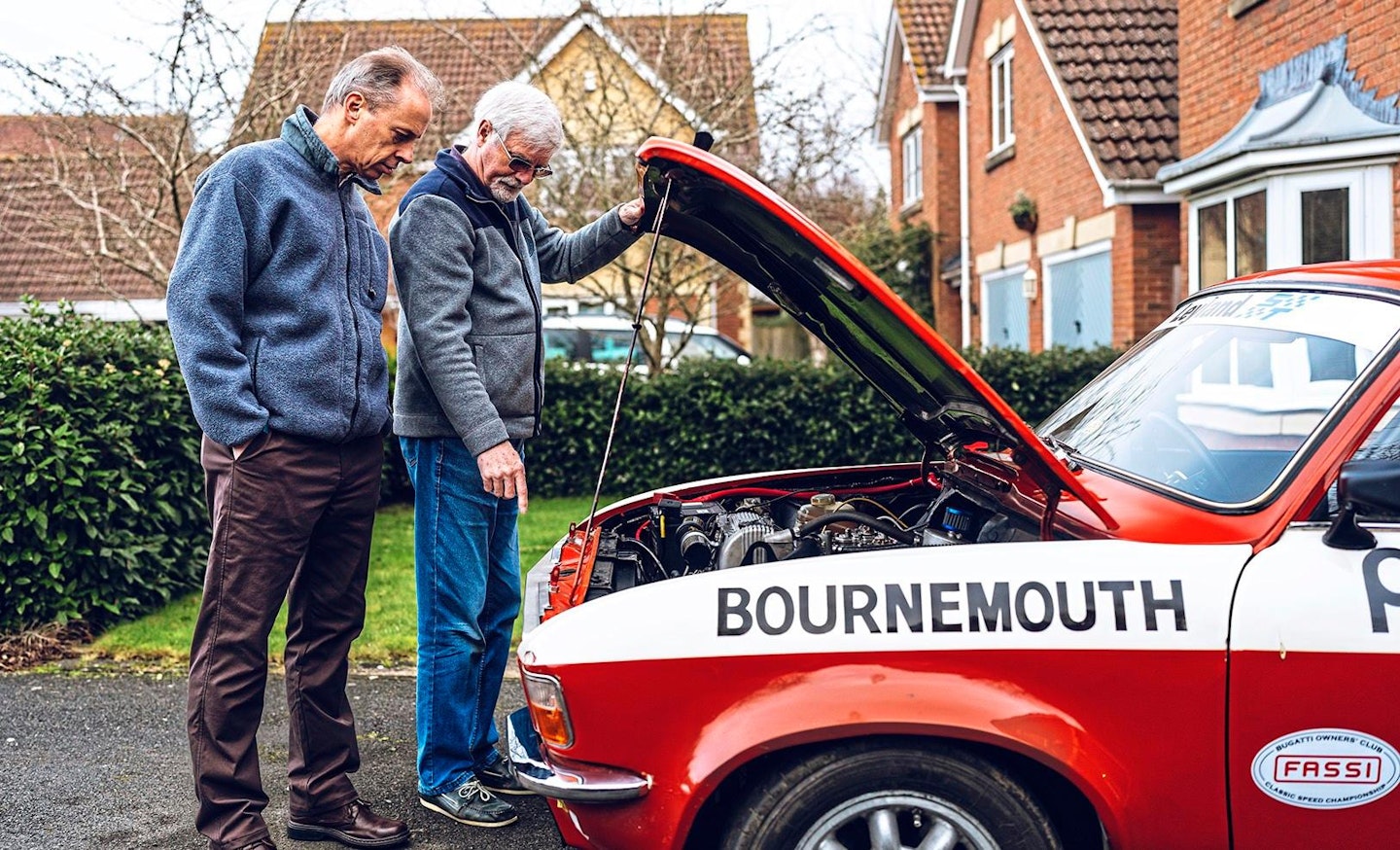
Engine rebuilt once more at start of 2025
Peter aimed to the get the car ready for the 2023 Owen Motor Club Graham Hill Trophy Sprint at Curborough, a milestone event for him. ‘I had driven the car at this event 45 years previously and was delighted to be able to use the same competition number. We managed to get some photographs taken at the very same paddock location and corner of the track. It was great to achieve this in the Allegro!’
‘I also registered to take part in the “Fassi” Classic Speed Championship of sprints and hillclimbs run by the Bugatti Owners Club. Throughout 2023 the car was very reliable, although it was down on power and using a lot of oil. I scored some points through the handicap system of the Speed Championship, and at the end of the season, I entered the Rallye Prescott event, looking forward to some timed runs both in daylight and darkness.
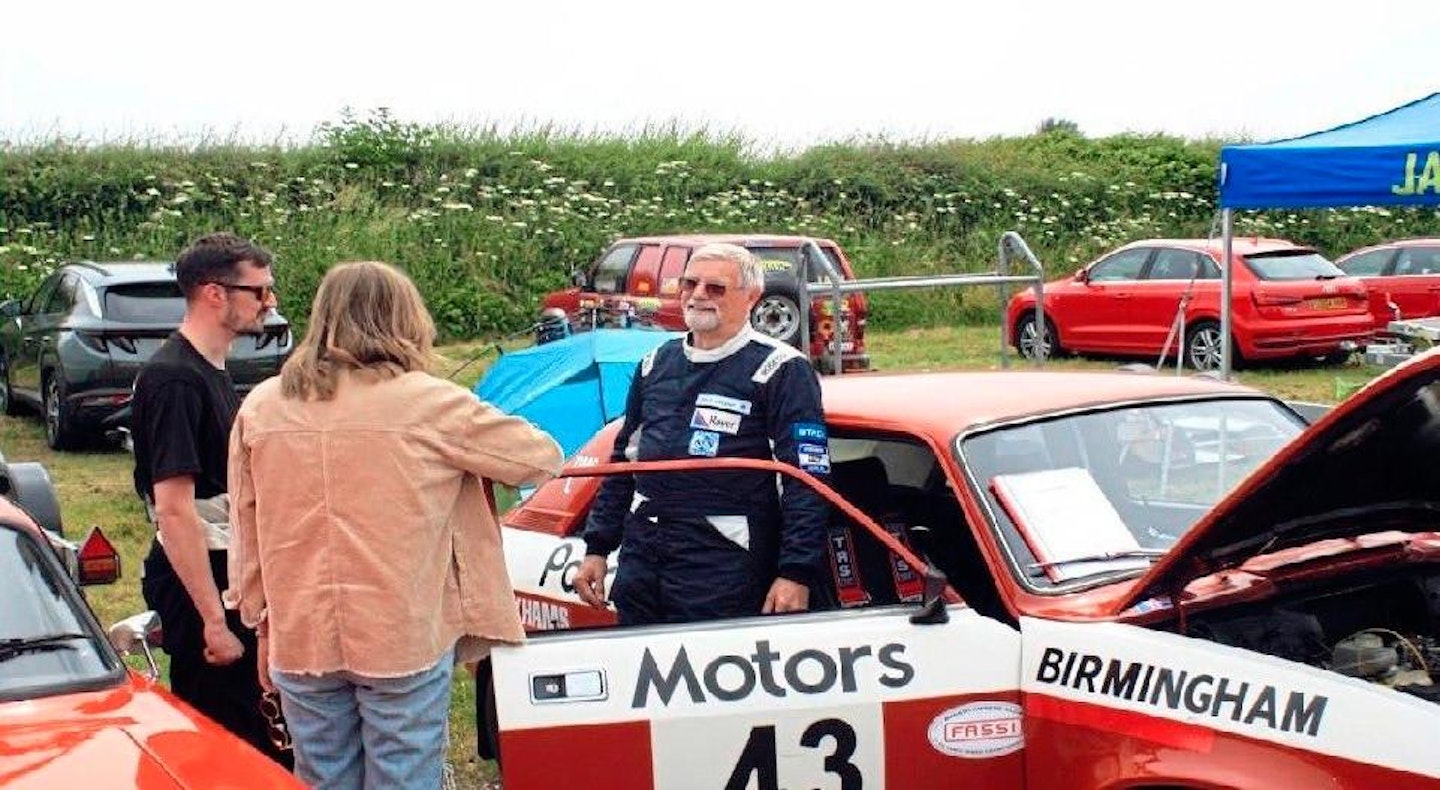
2023 Curborough Paddock, 45 years since the last time
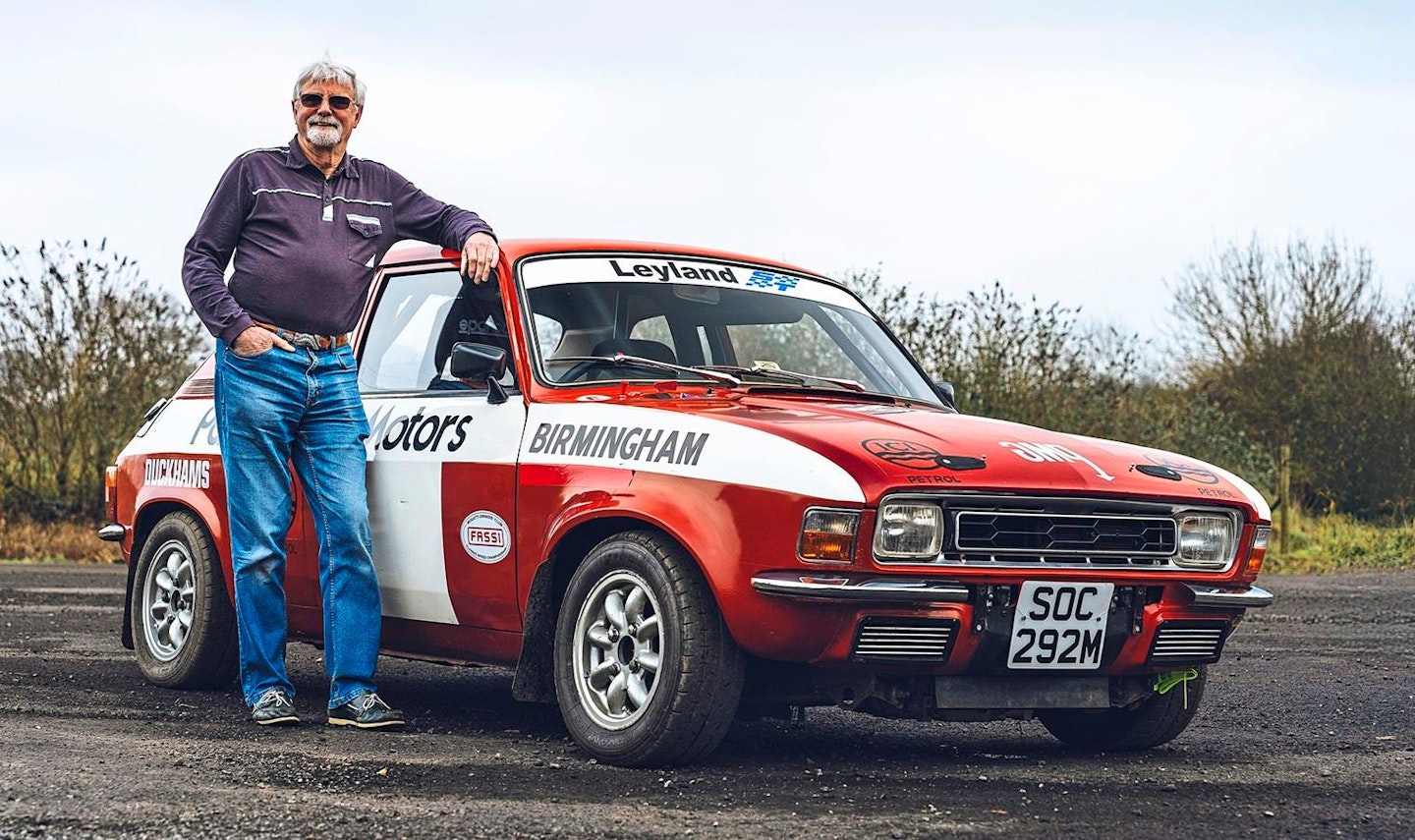
New rallying adventures await Peter and Allegro
‘On my first run, the car stopped at Pardon Hairpin and refused to restart. Thankfully, it was the only DNF of the year but it was a disappointing way to end. There was further dismay when a full engine stripdown revealed damage to number three piston as well as wear in the bores – shortly after the event I made the decision to buy a new cylinder block and also to have the crankshaft reground.
‘Unfortunately, during the 2024 season, the Allegro was less reliable, with problems at every one of the four events that I attended. Among the difficulties I had was finding a good quality supplier to make the special head gasket, which meant I resorted to using a standard one. It didn’t work well in competition conditions at all, with plenty of blue smoke on display at times! At Rallye Prescott, the distributor body broke on the first practice run, so the engine died before I reached the finish line.’
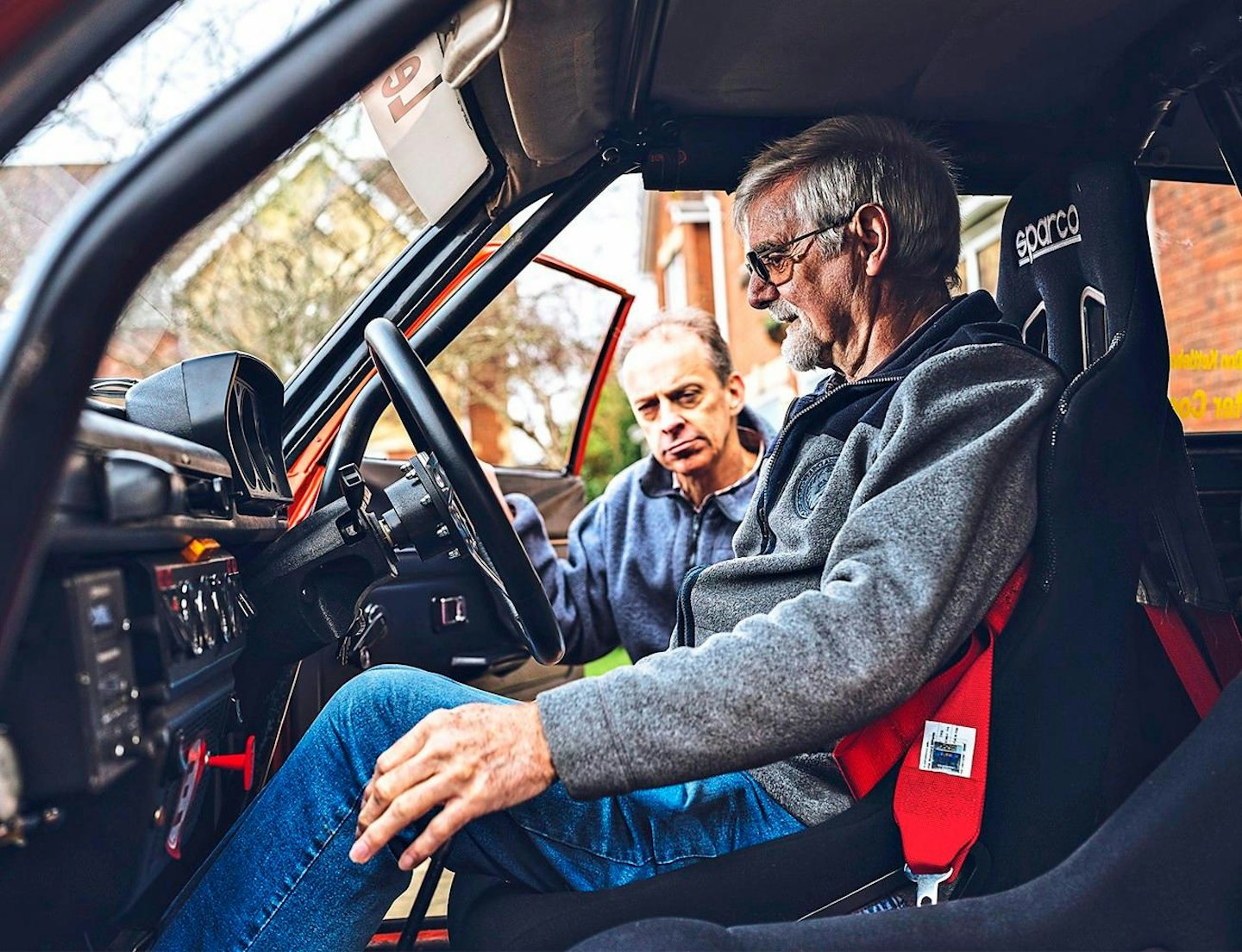
Peter and FEP5’s bond goes back over 40 years
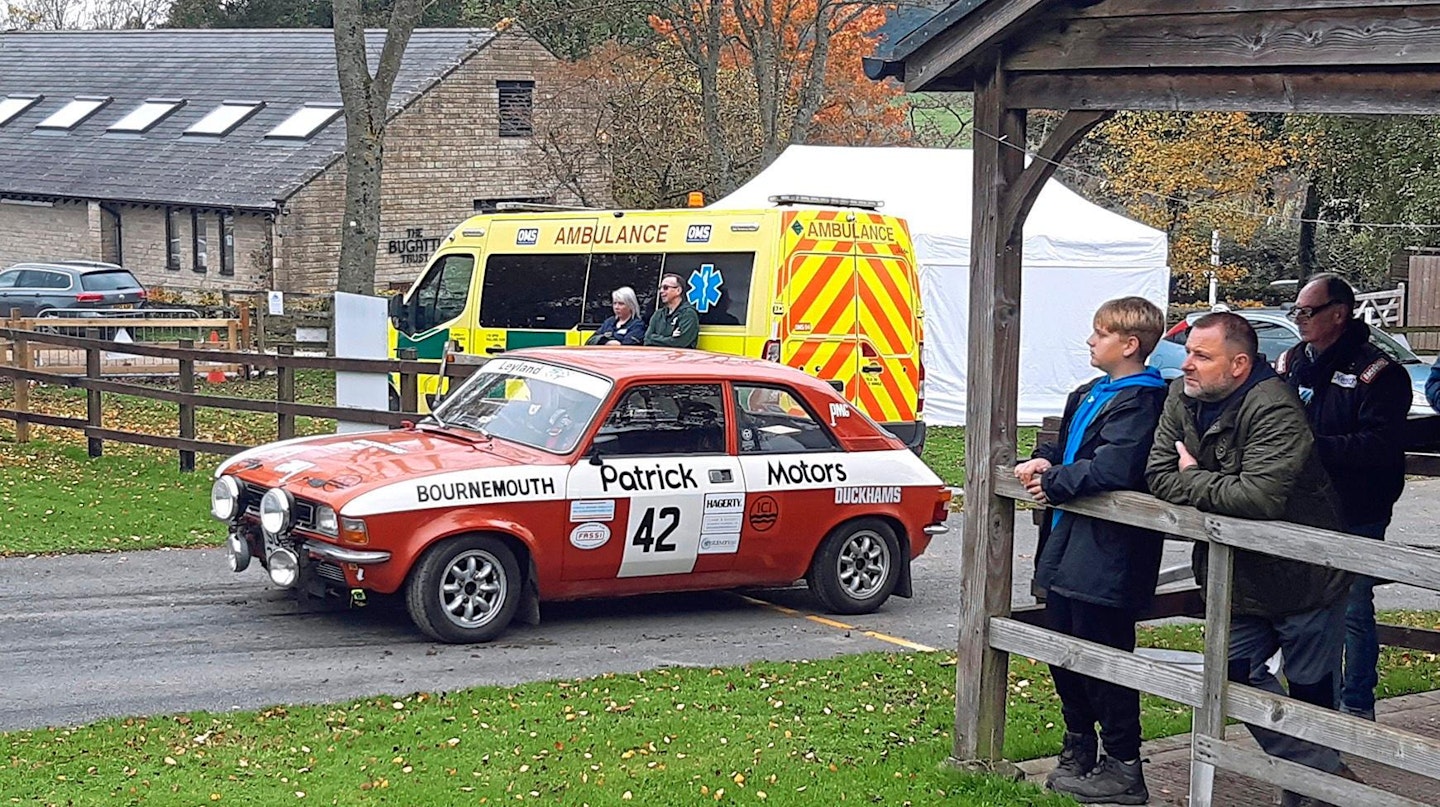
2024 Peter and Allegro Rally wait to start Rallye Prescott
Despite these setbacks, Peter is determined to get the car reliable again and in good shape for competition. ‘This year began with yet another engine rebuild. The unique head gaskets that I need are being manufactured from scratch to fit the block that had already been modified for the 2024 season. I’m aiming to get the previous reliability back but hopefully with a bit more power.
‘As with any old car, there are other challenges, too. The rare magnesium Minilite wheels will be refurbished and repainted, but there are very few wheel specialists that will work on magnesium, so that will involve a trip up to Yorkshire. But that’s all part of owning this car – it has the honour of being the oldest running Allegro, and it’s definitely going to be one that keeps on running!’
Know your classic’s previous owners?
Let us know at classic.cars@bauermedia.co.uk and it might make for one of our features
Subscribe to Classic Cars today. Choose a Print+ Subscription and you'll get instant digital access and so much more. PLUS FREE UK delivery.
